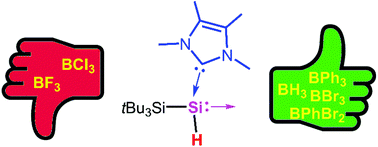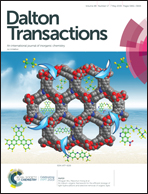Reactivity of an NHC-stabilized pyramidal hydrosilylene with electrophilic boron sources†
Abstract
Silylenes have become an indispensable tool for molecular bond activation. Their use for the construction of silicon–boron bonds is uncommon in comparison to the numerous studies on silylene-derived silicon-element bond formations. Herein we investigate the reactivity of the pyramidal NHC-coordinated hydrosilylene tBu3SiSi(H)LMe4 (1; NHC = N-heterocyclic carbene, LMe4 = 1,3,4,5-tetramethylimidazolin-2-ylidene) with various boron-centered electrophiles. The reaction of 1 with THF·BH3 or H3N→BH3 afforded the silylene complex 1→BH3 or the product of insertion of the silicon(II) atom into an N–H bond with concomitant dehydrogenation along the HN–BH moiety (2). The respective conversion of 1 with BPh3 yields 1→BPh3 which readily reacts with excess LMe4 to form the more stable complex LMe4→BPh3 with release of 1. Treatment of 1 with the haloboranes Et2O→BF3, BCl3, BBr3 and Me2S→BBr3 resulted in the formation of the Lewis acid base adducts 1→BX3 (X = F, Cl, Br) and an equilibrium with their auto-ionization products [12BX2]+[BX4]− slowly develops. The ratio of 1→BX3 significantly increases with rising atomic number of the halide, thus 1→BF3 majorly transforms within hours while 1→BBr3 is near-quantitatively retained over time. Accordingly, the complex 1→BPhBr2 was isolated after conversion of 1 with PhBBr2.

- This article is part of the themed collection: Inorganic chemistry of the p-block elements


 Please wait while we load your content...
Please wait while we load your content...